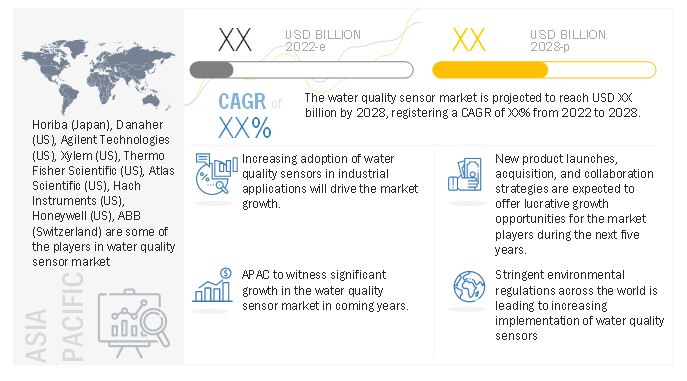Water Quality Sensor Market by Type (Residual Chlorine, TOC, Turbidity, Conductivity, pH, and ORP), by Application (Industrial, Agriculture, Wastewater Management, Drinking Water Treatment, and Aquaculture), and Region – Global Forecast to 2030
Water quality sensors are used for water quality monitoring. The data from the water quality sensors are used for various purposes which includes identifying compliance with regulatory water quality requirements, implementing a contamination warning system (CWS), identifying water quality for critical processes in industries, and verifying water quality modelling among others.
Various types of water quality sensors are available in the market including residual chlorine sensor, total organic carbon (TOC) sensor, turbidity sensor, conductivity sensor, pH sensor, and oxidation-reduction potential (ORP) sensor. Industrial, agriculture, wastewater management, drinking water treatment, and aquaculture are the key areas where water quality sensors find its applications.
The global water quality sensor market size is expected to grow from USD XX million in 2024 to USD XX million by 2030, at a CAGR of XX%. The growing awareness of the water quality measurement due to rising level of water pollution and increasing government funding for controlling and monitoring pollution are some of the key factors driving the market growth.

To know about the assumptions considered for the study, Request for Free Sample Report
Drivers: Increasing adoption of pH sensor for water quality measurement
pH sensor is one of the most used sensors for water quality measurements. In terms of water treatment and purity, a pH sensor is crucial. A water treatment plant's pH level can become dangerously high or low, which can make the water unsafe. This sensor can determine how much acidity and alkalinity is present in water. When utilised properly, pH sensors can guarantee a product's safety and quality as well as the operations that take place in a manufacturing or wastewater facility.
Drivers: High demand for water quality sensor from the APAC
The high demand from APAC region is one of the key factors accelerating the growth of the water quality sensor market. APAC is expected to hold dominant position in the water quality sensor market in the coming years as well. Major government initiatives such as river protection, smart cities, and smart water management systems in the region combined with scarcity of water are estimated to boost the market in APAC. Additionally, APAC has a significantly large population which offer significant opportunity for the market.
Challenges: Limited penetration of water testing and analysis instruments in non-industrial applications
High cost of water testing systems has led to limited penetration of water quality sensors in the non-industrial application. Additionally, lack of awareness about water quality especially in the rural areas of developing nations is also hindering the growth of the water quality sensor market.
Key Market Players:
Horiba (Japan), Danaher (US), Agilent Technologies (US), Xylem (US), Thermo Fisher Scientific (US), Atlas Scientific (US), Hach Instruments (US), Honeywell (US), and ABB (Switzerland) are some of the players in water quality sensor market.
Recent Developments
- In September 2022, South Fork Instruments (US) expands its turbidity sensor solutions with the launch of EXplore range of entry-level turbidity sensors. The advantage of the EXplore sensor is its high level of accuracy, that combined with a fast response, allows changes in the measured turbidity of fluid to be recorded in real-time
- In March 2020, ABB (Switzerland) launched a new range of color-coded sensors that makes it easy to choose and manage the optimal pH measurement solution. The application driven designs are categorized into three groups: the entry-level 100 series for cost-effective measurement in general process applications; the high-performance 500 series for harsh industrial applications; and the 700 series for specialist applications.
To speak to our analyst for a discussion on the above findings, click Speak to Analyst

TABLE OF CONTENTS
1 Introduction
2 Research Methodology
3 Executive Summary
4 Premium Insights
5 Market Overview
5.1. Introduction
5.2. Market Dynamics
5.2.1. Drivers
5.2.2. Restraints
5.2.3. Opportunities
5.2.4. Challenges
5.3. Pricing Analysis
6 Water Quality Sensors Market, By Type
6.1. Introduction
6.2. Residual Chlorine Sensor
6.3. Total Organic Carbon (TOC) Sensor
6.4. Turbidity Sensor
6.5. Conductivity Sensor
6.6. pH Sensor
6.7. Oxidation-Reduction Potential (ORP) Sensor
6.8. Others
7 Water Quality Sensors Market, By Application
7.1. Introduction
7.2. Industrial
7.3. Agriculture
7.4. Wastewater Management
7.5. Drinking Water
7.6. Aquaculture
7.7. Others
8 Geographical Analysis
8.1. Introduction
8.2. North America
8.3. Europe
8.4. Asia Pacific (APAC)
8.5. Rest of the World (RoW)
9 Competitive Landscape
9.1. Major 10 Company Competitive Analysis
9.2. Market Share Analysis
9.3. Company Evaluation Matrix
10 Company Profile
(Business Overview, Products Offered, Related Strategies and Developments, MnM Viewpoint)
10.1. Key Players Global
10.1.1. Horiba, Ltd.
10.1.2. Danaher Corporation
10.1.3. Agilent Technologies
10.1.4. Xylem, Inc
10.1.5. Thermo Fisher Scientific
10.1.6. Atlas Scientific
10.1.7. Hach Instruments
10.1.8. Honeywell
10.1.9. ABB Ltd
10.1.10. Hannah Instruments
10.1.11. Oakton
10.1.12. Siemens
10.1.13. Others
10.1.13.1. Badger Meter
10.1.13.2. Real Tech Inc.
10.1.13.3. Aqualitas Technologies
11 Appendix















Growth opportunities and latent adjacency in Water Quality Sensor Market